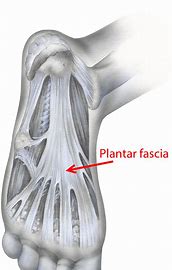
Our feet are unsung heroes, supporting us through countless steps each day. Yet, they are also vulnerable to injuries that can disrupt our daily activities. Chronic foot pain can significantly impede our mobility and quality of life. One prevalent condition that affects individuals across various walks of life is Plantar Fasciitis.

What is Plantar Fasciitis?
Plantar fasciitis manifests as inflammation in the tissue at the bottom (plantar) of the foot. This tissue, known as the plantar fascia, connects the heel to the balls of the feet. The condition typically results from repetitive strain, sudden tension, or trauma to this area.
Anatomy of the Plantar Aspect of the Foot
The plantar fascia plays a crucial role in foot function, supporting the arch, absorbing shock, and facilitating the propulsion of the foot during movement.
Predisposition and Risk Factors
Various factors contribute to the development of plantar fasciitis. Professions that involve prolonged standing or walking, such as nursing or trades with steel-toe boots, increase the risk. Engaging in activities like running, sports on turf or court, and dancing also heightens susceptibility. Structural factors like flat or high arches, tight calves, and excess weight can predispose individuals to this condition. Additionally, unsupportive footwear and walking on hard or uneven surfaces can strain the plantar fascia.

Exercises to prevent/rehab
- Arch Lifts: Begin in a seated position with your foot on the floor. Next, raise up the arch of the involved foot while maintaining your big toe, ball of your foot, and heel on the floor the entire time. Slowly return to start position. Do 3 sets of 10 repetitions, twice a day, for 5 days a week.
- Towel Scrunch Foot Exercise: Place a small towel flat on the ground. This exercise is performed in a seated position. So make sure your back is straight and the leg banked comfortably at 90° with your affected foot placed flat on the towel. Use your toes to begin to scrunch the towel with the aim of pulling the towel ends towards you. Do this in a slow and controlled manner. When you have pulled the towel end as far as possible, straighten it back out and repeat the process 3 to 5 times.
Prevention and Rehabilitation Tools
- Proper Footwear and Insoles: Supportive footwear and specialized insoles can aid in arch support and shock absorption, reducing strain on the plantar fascia.
- Cold Therapy (Ice): Applying ice at night can alleviate night-time pain resulting from a day spent on one’s feet.
- Morning Foot Rolling/Heat: Engaging in foot rolling exercises or using heat in the morning can prepare the tissues for movement, minimizing strain throughout the day.
While plantar fasciitis can be debilitating, it’s a condition that can often be prevented or managed with the right tools and practices. By understanding the risk factors and employing preventive measures like proper footwear, targeted exercises, and managing strain, individuals can significantly reduce the likelihood of developing plantar fasciitis.
Remember, taking proactive steps to care for your feet can make a substantial difference in preventing foot pain and maintaining overall foot health. If you’re prone to the risk factors associated with plantar fasciitis, incorporating these practices into your daily routine can contribute to healthier feet and ankles.






